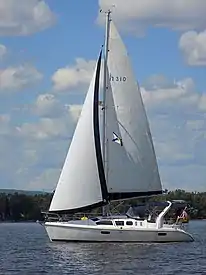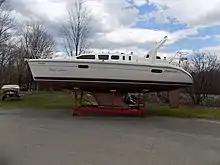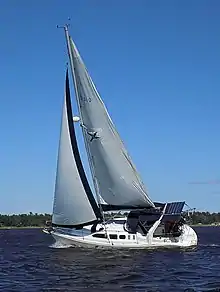Hunter 310
The Hunter 310 is an American sailboat, that was designed by the Hunter Design Team and first built in 1997.[1][2]
 | |
| Development | |
|---|---|
| Designer | Hunter Design Team |
| Location | United States |
| Year | 1997 |
| Builder(s) | Hunter Marine |
| Name | Hunter 310 |
| Boat | |
| Displacement | 8,500 lb (3,856 kg) |
| Draft | 5.50 ft (1.68 m) |
| Hull | |
| Type | Monohull |
| Construction | Fiberglass |
| LOA | 30.83 ft (9.40 m) |
| LWL | 28.00 ft (8.53 m) |
| Beam | 10.83 ft (3.30 m) |
| Engine type | Yanmar 18 hp (13 kW) diesel engine |
| Hull appendages | |
| Keel/board type | fin keel |
| Ballast | 3,000 lb (1,361 kg) |
| Rudder(s) | internally-mounted spade-type rudder |
| Rig | |
| Rig type | B&R rig |
| I foretriangle height | 37.08 ft (11.30 m) |
| J foretriangle base | 11.67 ft (3.56 m) |
| P mainsail luff | 39.08 ft (11.91 m) |
| E mainsail foot | 12.67 ft (3.86 m) |
| Sails | |
| Sailplan | Fractional rigged sloop |
| Mainsail area | 247.57 sq ft (23.000 m2) |
| Jib/genoa area | 216.36 sq ft (20.101 m2) |
| Total sail area | 463.93 sq ft (43.101 m2) |
| Racing | |
| PHRF | 168 (average) |
|
| |
The 310 design was developed into the Hunter 320 in 2000.[3]
Production
The boat was built by Hunter Marine in the United States, but it is now out of production.[1][2][4]
Design

The Hunter 310 is a small recreational keelboat, built predominantly of fiberglass. It has a fractional sloop Bergstrom & Ridder rig, an internally-mounted spade-type rudder and a fixed fin keel. It displaces 8,500 lb (3,856 kg) and carries 3,000 lb (1,361 kg) of ballast.[1]
The boat has a draft of 5.50 ft (1.68 m) with the standard keel and 4.00 ft (1.22 m) with the optional shoal draft keel.[1][2]
The boat is fitted with a Japanese Yanmar diesel engine of 18 hp (13 kW). The fuel tank holds 25 U.S. gallons (95 L; 21 imp gal) and the fresh water tank has a capacity of 20 U.S. gallons (76 L; 17 imp gal).[1][2]
The design has a PHRF racing average handicap of 168 with a high of 182 and low of 162. It has a hull speed of 7.09 kn (13.13 km/h).[2][5]
Operational history

A review by Darrell Nicholson of Practical Sailor described the design as an "innovative family boat typifies Hunter’s design philosophy with its B&R rig, radar arch, circular cockpit and good value, but owners cite numerous niggling problems." On saling performance he wrote, "Sailing performance depends on a variety of elements. When hull form, sail plan, displacement, and foil shapes harmonize, the 310 sings, but that doesn’t always happen .. her sail area is small, just 455 sq. feet, less than any cruiser —save the Catalina 30 short rig—in her class. On the drawing board the 310's sail area may balance her design displacement. On the water a small sail plan usually gets overwhelmed by actual displacement. It's nice to have sailpower in reserve when the inevitable weight of cruising gear gets added to a boat. The 310 has no such margin. This hampers pure performance, but allows pleasing performance—that combination of good speed, sailing ease, and a sense of security that can make a boat fun even if she isn't overly fast. The 310 is a good example of how Hunter tries to keep the sizzle in sailing while tuning down the complexity and factoring out the fear."[6]
See also
Similar sailboats
References
- Browning, Randy (2018). "Hunter 310 sailboat specifications and details". sailboatdata.com. Archived from the original on 25 March 2022. Retrieved 7 April 2018.
- Sea Time Tech, LLC (2022). "Hunter 310". sailboat.guide. Archived from the original on 25 March 2022. Retrieved 25 March 2022.
- Browning, Randy (2018). "Hunter 320 sailboat specifications and details". sailboatdata.com. Archived from the original on 25 March 2022. Retrieved 18 November 2018.
- Browning, Randy (2018). "Hunter Marine". sailboatdata.com. Archived from the original on 30 July 2020. Retrieved 7 April 2018.
- InterVisionSoft LLC (2018). "Sailboat Specifications for Hunter 310". Sailing Joy. Archived from the original on 8 May 2018. Retrieved 7 April 2018.
- Nicholson, Darrell (24 August 2000). "Hunter 310". Practical Sailor. Archived from the original on 28 July 2022. Retrieved 28 July 2022.